The HMA 1 "the Mayfly"
edited from the
Airship Heritage Trust

|
Statistics:
|
Length |
512ft |
Diameter |
46ft |
Speed
|
42mph
(anticipated) |
Engines |
2 x 180hp |
Volume |
663, 518cft |
Following in the
footsteps of Count Zeppelin and the success of his early rigid
airships, in 1908 the British Government agreed a sum of £35,000
which “should be allocated to the Admiralty for the building of a
dirigible balloon”. This was in fact a direct attempt to compete with
the Germans with the designing and building of the first British
rigid Airship.
Following in the
footsteps of Count Zeppelin and the success of his early rigid
airships, in 1908 the British Government agreed a sum of £35,000
which “should be allocated to the Admiralty for the building of a
dirigible balloon”. This was in fact a direct attempt to compete with
the Germans with the designing and building of the first British
rigid Airship.
Designs were already
being submitted and on 7th May, 1909 the award was given to the
Vickers Company. The original contract had been for a ship to be
constructed for £35,000, however Vickers advised that they could
construct the ship for £28,000 without goldbeaters skin gasbags and
varnished skin outer cover. This would be up to the Admiralty to
provide contractors for. They also asked if they put up a
constructional shed, free of cost to the Crown so that they may have
a ten year monopoly of airship construction, as they did with the
submarine boat agreement they had with the Crown. On May 7th the
contract was awarded but with the refusal on the 10 year monopoly
clause.
By 1910 the British
Government had committed themselves to a similar path of air-weapon
development to that taken by Germany. However is was originally
planned that the ship be used for scouting capabilities. The project
to build the first ship had begun, and designated “HMA No. 1” or more
commonly known as “The Mayfly”. The design team were working on
something that could match that of the current Zeppelins of the time.
These could fly 100 miles, carry a crew of 26, and get to 5,400 ft
with an endurance of twelve and a half hours.
The Floating Hanger at Cavendish Dock
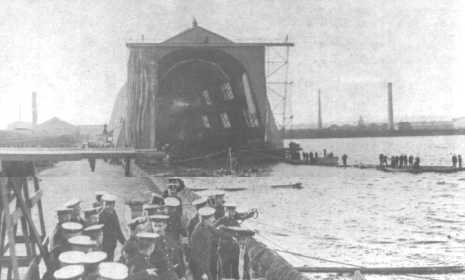
Built along similar
lines of the very early Zeppelins, but with some major modifications
which at the time can be seen as remarkable. Her original design was
for that of an aerial scout capable of 40 knots for 24 hours,
moorable on water with a ceiling of 1,500 ft., wireless equipment and
comfort for a crew of 20. The design was 66ft longer than her current
German Contemporary, the LZ-6, and she had a 50% greater volume. Not
only would have this given her a correspondingly greater lift value
than the LZ-6 but, because “the Mayfly” was constructed with
Duralumin and not aluminium, which the Germans would not use for
another four years, then further weight saving assets were to be
gained.

Plan of the HMA No1. click to
enlarge
The engine cars had
been hand crafted out of watertight mahogany, each carrying one
marine racing engine. Each engine drove a pair of 15ft diameter
wooden propellers, mounted on the outside of the gondolas, at half
engine speed.
Work began 1909 both
on the ship and also on the shed, which was originally described as a
garage. The shed designed by Vickers was built from the wall of
Cavendish Dock out to piles driven into the basin floor. Once this
was completed in mid-1910, the actual erection of No.1 began. The
mooring was to be to a mast and the British were the first to use it
as standard equipment. The Mayfly was the first of the rigids to be
fitted out with the mooring equipment in the nose of the ship. The
design of the ship was quite revolutionary in being it was in fact
more streamlined than those of contemporary Zeppelins, and in fact
the No 9, 23 or 23X class which was to follow. The shape gave a 40%
head resistance compared to existing Zeppelins. It was not until the
R80 that a truly streamlined ship was constructed, and this original
idea was suggested for the Mayfly, but the Admiralty rejected it.

Plan of the cabin in the Keel.
click to enlarge
The main delay
between design and completion of the ship was due to the delay in
completion of the shed. The shed was to be completed in August 1909
and the ship be delivered two months later, but in June trouble
occurred with driving piles in to the floor of the dock, and caused
the shed completion to be delayed until June 1910.
In the spring of 1910
the new crew began training and then moved on to the shed in
September of 1910. On February 13th, 1911 the Mayfly made her shed
trials. The motors were run and controls operated but outdoor trials
could not be completed until the weather moderated. It was not until
March that the crew were reported ready for launching the great
experimental ship.
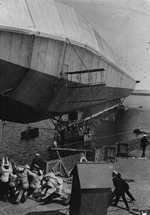
click to enlarge
A new design of
floating mast was erected some 38ft high, and a "screen" was erected.
The mooring was designed to have a steady pull of some 80 tons,
however the maximum pressure the ship exerted on the mast in a wind
of 80mph was some 4 tons, and hence a large safety margin has been
calculated.

click to enlarge
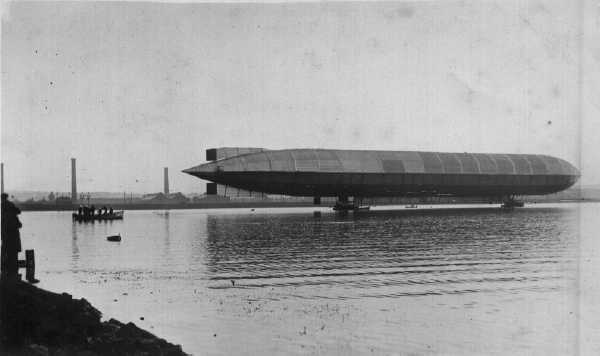
The ship emerging from the Dock to the floating mast.
click to enlarge
Some details of the
ship have come to light following the discovery of the "Handbook for
HMA No1" which some of the following details have been taken :-
" crew :- Two
crews were used to look after the ship whilst out, as the work was
new. They lived on board the airship and suffered no discomfort at
all although no provision had been made for cooking or smoking on
board. At night the temperature of the living space was a little
above that of the outside air, but as the ship proved quite free from
draughts in the keel and the cabin, it was anticipated that with
suitable clothing, no trouble would be experienced from the cold."
Training of the
Airships Crew :
Joined January
25th 1910
February - At Messrs Short Brothers works, Battersea, receiving the
following instruction in working rubber fabric:-
Making joints in
sheets on the flat
Making joints in sheets on the curve
Making fabric pipes and joins in curve.
Making model gas bags
Sticking channel fabrics to gas bags
March - Instructions in petrol engines at Barrow. Lectures on
parting, running and adjusting 15hp Wolsley motor car engine.
April - Signals. Lectures and instruction in aeronautics and
meteorology
May - Further experience in working gas bags and outer cover etc.
When the first
calculations on weighing the ship had been made, it was discovered
that she was too heavy, and after removal of some fixtures to the
weight of some three tons, there was some hope that the ship would
become airborne.
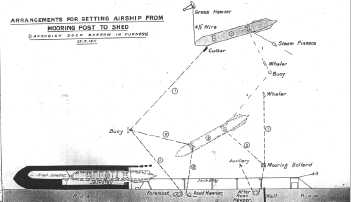
A drawing showing the way the ship was drawn out of
the shed. click to enlarge
After more drastic
surgery on the ship, the ship was hauled out of her shed on Monday
22nd May, stern first, by boats attached to her side. She was
gradually swung out of Cavendish Dock and attached to a mooring
pontoon there. Whilst she was at the mast, nine officers remained on
board, and engine trials were conducted although cut short as there
were trouble with the radiators. On Tuesday May 23rd she withstood
winds of 45 mph, and whilst the two nights she was out on the lake,
searchlights were played across her so that her actions could be
observed. Those who stayed aboard had quarters in the keel and
telephone communications between the cars. It was seen that the ship
would not rise and decided that the ship be retuned to the shed. It
was discovered that that whilst in her shed, t he ship floated for
some 5 hours with both gondolas some 4 ft out of the water. During
this time the ship was used for trimming trials.
During her time in
the shed a new system was devised for removing her from the shed. A
series of electric winches would be used to ease her out, even
against a beam wind. By 24th September 1911, the decision was mate to
mover her out of her hanger for full testing. However, disaster
struck in the form of a sudden forceful beam-side gust causing the
ship to lurch, just clearing the shed but laid her on to her beam
ends. She righted and was them being pivoted so that her nose would
point back out to the dock when there were cracking sounds amidships
and she broke in two. She started to rise in an inverted "V"
formation but t he crew in the after gondola dived overboard and the
stern flew up in to the air.
The wreck was
returned to the shed the same day. The Court decided that there was
no one to blame of this incident and it would be reasonable to
support the story that the squall was to blame. It was of such a
force that later ships would have also been severely damaged if they
had encountered it under the same tethered circumstances.
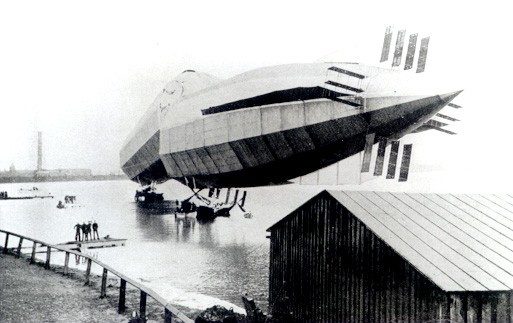
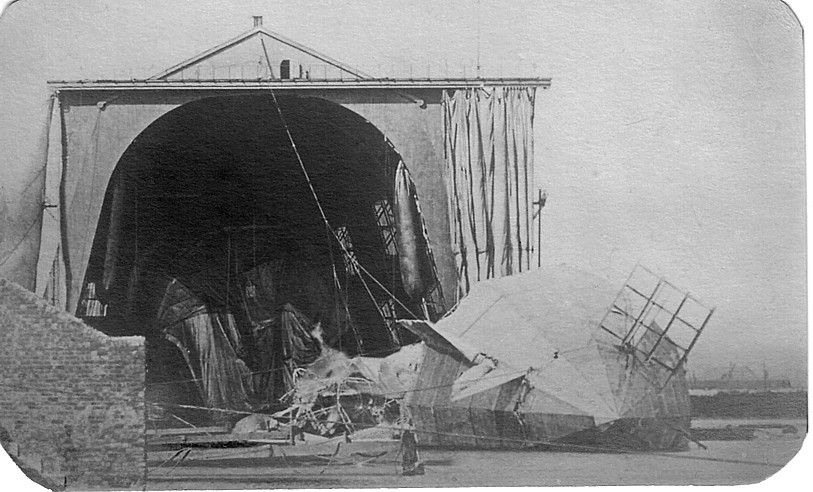
Images of the wrecked ship click
to enlarge
The ship was left to
rot in her shed, when many decisions and arguments were made in the
Admiralty regarding the future of Naval Airship operations. However
her brief career had supplied an immense amount of valuable
information for British Scientists. She may not have flown but she
was not a dead loss. |
